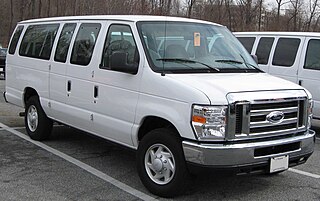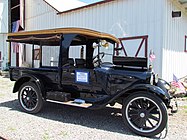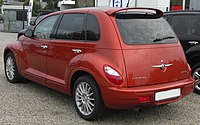Dodge is an American brand of automobiles and a division of Stellantis, based in Auburn Hills, Michigan. Dodge vehicles have historically included performance cars, and for much of its existence Dodge was Chrysler's mid-priced brand above Plymouth.

A sport utility vehicle (SUV) is a car classification that combines elements of road-going passenger cars with features from off-road vehicles, such as raised ground clearance and four-wheel drive.

A van is a type of road vehicle used for transporting goods or people. Depending on the type of van, it can be bigger or smaller than a pickup truck and SUV, and bigger than a common car. There is some variation in the scope of the word across the different English-speaking countries. The smallest vans, microvans, are used for transporting either goods or people in tiny quantities. Mini MPVs, compact MPVs, and MPVs are all small vans usually used for transporting people in small quantities. Larger vans with passenger seats are used for institutional purposes, such as transporting students. Larger vans with only front seats are often used for business purposes, to carry goods and equipment. Specially-equipped vans are used by television stations as mobile studios. Postal services and courier companies use large step vans to deliver packages.

Plymouth was a brand of automobiles produced by Chrysler Corporation and its successor DaimlerChrysler. The brand was launched in 1928 to compete in what was then described as the "low-priced" market segment that was dominated by Chevrolet and Ford. It became a high-volume seller for the automaker until the late 1990s. Plymouth cars were marketed primarily in the United States. The brand was withdrawn from the marketplace in 2001. The Plymouth models that were produced up to then were either discontinued or rebranded as Chrysler or Dodge.

The Ford E-Series is a range of full-size vans manufactured and marketed by the Ford Motor Company. Introduced for model year 1961 as the replacement for the Ford F-Series panel van, the E-Series line is currently in its fourth generation.

The Chevrolet Express, also rebadged as the GMC Savana, is a range of full-size vans built and sold by General Motors since the 1996 model year, succeeding the prior GM G-series vans, which were marketed as the Chevrolet Van and GMC Rally/Vandura. The Express/Savana was updated for the 2003 model year with revised styling and chassis upgrades.

Ford Courier is a model nameplate used by Ford since the early 1950s. The Courier moniker has been used on a variety of vehicles all around the world since it was first used in North America for a saloon delivery. The Courier nameplate was also used by Ford for a series of compact pickup trucks and would also see use by Ford of Europe denoting a Fiesta-based panel van. Ford Brazil used the nameplate for a Fiesta-based coupe utility pickup marketed across Latin America.

The Chevrolet Lumina APV is a minivan that was produced by the Chevrolet division of General Motors. The first front-wheel drive minivan sold by Chevrolet, the Lumina APV was sold in a single generation from the 1990 to 1996 model years. Marketed alongside the Pontiac Trans Sport and Oldsmobile Silhouette, the Lumina APV competed against the Dodge Grand Caravan/Plymouth Grand Voyager, the extended-length Ford Aerostar, and the Mazda MPV.

The Chevrolet HHR is a retro-styled, high-roofed, five-door, five-passenger, front-wheel drive wagon designed by Bryan Nesbitt and launched by the American automaker Chevrolet at the 2005 Los Angeles Auto Show as a 2006 model.

Body-on-frame, also known as ladder frame construction, is a common motor vehicle construction method, whereby a separate body or coach is mounted on a strong and relatively rigid vehicle frame or chassis that carries the powertrain and to which the wheels and their suspension, brakes, and steering are mounted. While this was the original method of building automobiles, body-on-frame construction is now used mainly for heavy trucks, pickups, and predominantly large SUVs.

The C series is a line of pickup trucks sold by Dodge from 1954 until 1960. It replaced the Dodge B series of trucks and was eventually supplanted by the Dodge D series, introduced in 1961. Unlike the B series, which were closely related to Dodge's prewar trucks, the C series was a complete redesign. Dodge continued the "pilot house" tradition of high-visibility cabs with a wraparound windshield introduced in 1955. A two-speed "PowerFlite" automatic transmission was newly available that year. The Dodge Town Panel and Town Wagon also used the new design.

A panel van, also known as a blind van, car-derived van or sedan delivery, is a small cargo vehicle with a passenger car chassis, typically with a single front bench seat and no side windows behind the B-pillar. Panel vans are smaller than panel trucks or cargo vans, both of which use body-on-frame truck chassis.

A box truck—also known as a box van, cube van, bob truck or cube truck—is a chassis cab truck with an enclosed cuboid-shaped cargo area. On most box trucks, the cabin is separate to the cargo area; however some box trucks have a door between the cabin and the cargo area.

A ute, originally an abbreviation for "utility" or "coupé utility", is a term used in Australia and New Zealand to describe vehicles with a tonneau behind the passenger compartment, that can be driven with a regular driver's license.

The Advance-Design is a light and medium duty truck series by Chevrolet, their first major redesign after WWII. Its GMC counterpart was the GMC New Design. It was billed as a larger, stronger, and sleeker design in comparison to the earlier AK Series. First available on Saturday, June 28, 1947, these trucks were sold with various minor changes over the years until March 25, 1955, when the Task Force Series trucks replaced the Advance-Design model.

The Task Force is a light and medium duty truck series by Chevrolet, their first major redesign since 1947. Its GMC counterpart was the GMC Blue Chip series. It was billed as being more stylish compared to the earlier Advance Design Series while still maintaining its rugged durability. First available on March 25, 1955, these trucks were sold with various minor changes over the years until 1959, when the C and K Series trucks replaced the Task Force models for 1960.

Multi-stop trucks are a type of light-duty and medium-duty truck created for local deliveries to residences and businesses. They are designed to be driven either sitting down or standing up, and often provide easy access between the driver and goods, hence the name “walk-in delivery” van. They are taller than full-size vans, such as the Ford Econoline, Dodge A-Series/B-Series/Ram Vans, and Chevrolet G-Series vans, but can have wheelbases that are shorter than these models or longer.

The Dodge Town Panel and Dodge Town Wagon are respectively a panel truck and a carryall, manufactured between 1954 and 1966 in the USA and between 1954 and 1971 in Argentina by Dodge. The Town Panel and Town Wagon trucks were based upon the design of the Dodge C Series pickup trucks with round fenders and wraparound windshields. Even after the Dodge D Series "Sweptline" pickup trucks with square fenders and flat windshields were released, the Town Wagons retained the 1958 sheet metal design of the C Series pickups and heavy-duty trucks. They were produced until 1966, when the Dodge A100 Commercial and passenger vans eliminated the need for the pickup chassis version. A passenger sport utility version of the Dodge D series truck was not again developed until the third generation D Series based Dodge Ramcharger, a competitor to the Chevrolet Blazer.

The Chevrolet Van or Chevy Van is a range of vans that was manufactured by General Motors from the 1964 to 1996 model years. Introduced as the successor for the rear-engine Corvair Corvan/Greenbrier, the model line also replaced the panel van configuration of the Chevrolet Suburban. The vehicle was sold both in passenger van and cargo van configurations as well as a cutaway van chassis that served as the basis for a variety of custom applications.

A coupé utility is a vehicle with a passenger compartment at the front and an integrated cargo tray at the rear, with the front of the cargo bed doubling as the rear of the passenger compartment.



























